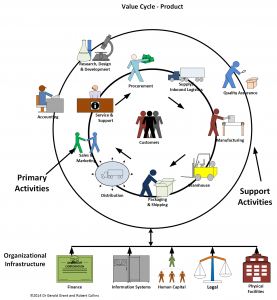By Gerald Grant, Ph.D.
November 4, 2016
We are often sold the idea that if we invest in information technology “solutions” such as “big data”, ERPs, social media among otherss, we will become better at collaborating and making informed, timely, and good decisions. Yet, what we experience is often the opposite. Many IT investments, instead of simplifying and smoothing information flows in organizations, only serve to complicate and create new information bottlenecks and costs. I remember a time when enterprise resource planning systems (ERPs) and corporate performance management systems (CPMs) were to provide “one version of the truth” in the organizations. While some organizations used these systems to systematize and standardize data flows, others, having focused on technology characteristics and features, ended up with more complex and disconnected technology platforms. Managing information flows on such platforms is difficult, time-consuming, and costly.
In my previous blog (https://itvalueimperative.com/make-sure-you-understand-your-organizations-value-cycle-when-investing-in-it/) I talked about the need for organizations to understand their value cycles. Value cycles become efficient and effective if there are smooth information flows between the processes and activities within them. This is where IT investments can make a significant contribution. Managers should not invest in IT that does not contribute to making information flows more efficient and effective. Such investment will only increase IT management and operational efforts leading to higher business costs overall. Some groups, within organizations, are intent on investing in “best of breed” IT systems that suit their particular process requirements but might have difficulty “talking” to other processes. Many others implement rogue IT systems that are disconnected from the underlying platform. All of these types of investments are likely to increase both operational difficulties and business costs. The technology, initially, might appear attractive and less expensive but the cost of integration and subsequent upgrading and renewal often is much more than the savings realized when the technology was purchased.

One branch of information economics focuses on the idea of information asymmetry. Information asymmetry occurs when one party in a transaction has different information from the other party. The idea of information asymmetry is very important and insightful when we analyze the value cycle of any organization. If one process has different information from another the cost of completing the transaction between the two processes will increase and the trust in that information will decrease. For example, if the warehouse receiving system has a different part numbering approach to the production system much effort will have to be put into reconciling those two sets of data. This automatically increases the cost of the overall system and decreases the potential profit from operations.
So, when IT investment decisions are being made, both business and technology leaders must contemplate whether such investments will contribute to smoothing information flows across the value cycle or increasing information asymmetry. If they increase information asymmetry, you are automatically building in significant current and future integration difficulties and costs. Don’t invest in IT that increases information asymmetry.
